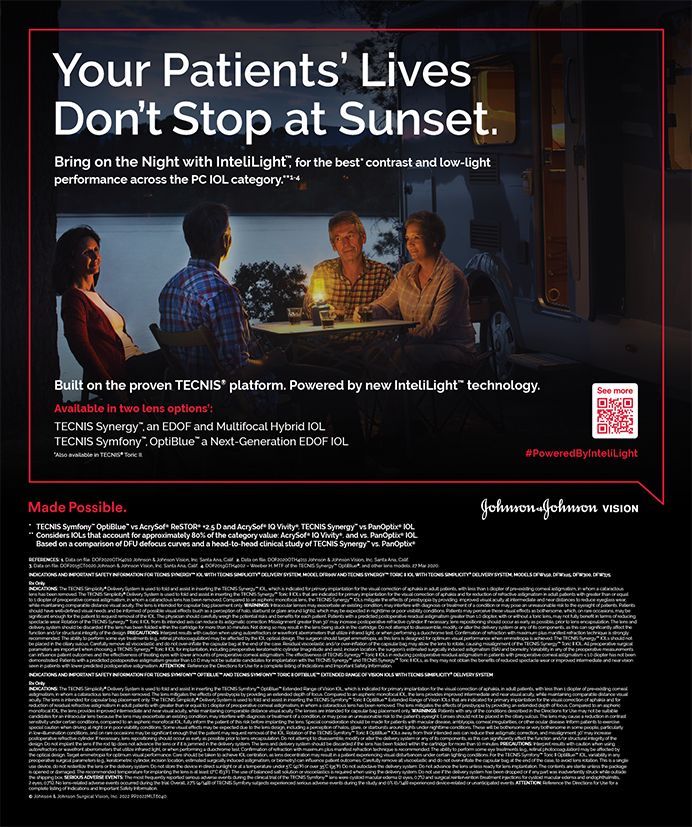In my practice, which comprises both corneal and refractive surgery, I still find computerized videokeratography to be the most useful adjunctive diagnostic tool and routinely use it in my surgical planning. Videokeratography is critical to the preoperative screening of candidates for laser refractive surgery. It is also essential for planning surgical procedures such as astigmatic keratotomy, penetrating keratoplasty, cataract surgery, and the insertion of intracorneal ring segments such as Intacs (Addition Technology, Inc., Des Plaines, IL). I still use the old standard videokeratographer, which gives both sagittal and tangential displays. I have not found it important to own devices that give me extrapolated information about the posterior surface of the eye.
LIMITATIONS AND EFFECTIVE USAGE
I have become much more aware of the limitations of videokeratography over the years and have added two complementary diagnostic devices to my decision-making process. They are an optical coherence tomography (OCT) device and wavefront technology. I primarily use them in situations where I am evaluating corneal topographic maps that are suspicious for keratoconus during refractive surgery screening.
The keys to using videokeratography effectively are understanding its limitations and learning what normal topography looks like in order to instantly recognize abnormality. Normal corneas tend to display a high degree of symmetry, both within eyes and between the two eyes of the same patient. Although most corneas are aspheric, flattening from the center to the periphery, there is a great variation in the videokeratographic patterns of normal eyes. My colleagues and I published this variation in a study of 200 normal eyes in 1996.1
Two patterns that are rarely seen in normal eyes are circumscribed inferior steepening and an asymmetric bowtie with skewed steep radial axes above and below the horizontal meridian. Both of these patterns could be signs of early keratoconus, despite the cornea’s appearing clinically normal on slit-lamp evaluation. There are several situations in which inferior steepening by itself can be artifactual, which needs to be carefully excluded prior to concluding that the inferior steepening is real. The following situations can present as inferior steepening that is artifactual: (1) contact lens warpage, (2) dry eye disease, (3) the technician’s compression of the lower part of the eyeball, and (4) incomplete digitization of the rings in the outer peripheral cornea. Inferior steepening may also merely be a normal variant.
In situations with inferior steepening when I am not sure whether I am dealing with forme fruste keratoconus or a variation of normalcy, I use the following technologies to help me make a decision: videokeratographic indices (inferior-superior [I-S] value), wavefront analysis, and OCT. If there is inferior steepening, it is wise to quantify the amount, and the I-S value is a good way to do this. It is the most studied index in the literature on keratoconus, and the way to calculate it is well described.2,3 If the I-S value is greater than three standard deviations of normal, it is clearly abnormal; it should raise suspicions and motivate further investigation. Careful retinoscopy could be useful to see if there is scissoring of the red reflex. If that is normal, I perform a wavefront analysis. When the patient has a significant amount of coma, I do not consider LASIK.4 I also perform OCT on all of my patients.
If the cornea is thinner in the area of inferior steepening, or even if the cornea just does not get thicker from the center to the periphery, I become highly suspicious and do not perform LASIK (Figure 1). Typically, in cases of contact lens warpage or normal inferior steepening, there will be no thinning of the cornea on OCT. A crabclaw appearance on topography or just central flattening inferiorly is an early sign of pellucid marginal degeneration. LASIK should be avoided in these patients5 (Figure 2).
ADDITIONAL APPLICATIONS
I routinely use corneal topography to plan for Intacs surgery in patients with mild-to-moderate keratoconus. I like to have the ring segment bisect the thinnest or steepest area of the cone. What I have learned over the years is that the sagittal mode can be misleading. Because data are being extrapolated from the center of the cornea, the clinician does not get a good idea of the true shape of the cone. The tangential mode provides a better indication of the shape of the cone and its true location. Once again, using OCT as an adjunct is useful for confirming the location of the thinnest area of the cornea.
Finally, videokeratography is very helpful for reducing astigmatism after corneal transplantation. Topographic maps will often demonstrate that the steepest areas are nonorthogonal and guide the placement of astigmatic incisions for best effect.6
Yaron S. Rabinowitz, MD, is the director of the Cornea Eye Institute in Los Angeles. He is in private practice in Beverly Hills and focuses on cornea and refractive surgery. Dr. Rabinowitz is the director of ophthalmology research at Cedars-Sinai Medical Center and a clinical professor of ophthalmology at UCLA School of Medicine in Los Angeles. He has held an NIH grant to study the topography and genetics of keratoconus for the past 20 years. He acknowledged no financial interest in the products or companies mentioned herein, but he holds a copyright on the software that calculates the I-S value. Dr. Rabinowitz may be reached at (310) 423-9640; rabinowitzy@cshs.org.
- Rabinowitz YS,Yang H, Elashoff J, et al.Videokeratography database of normal human corneas.Br J Ophthalmol. 1996;80:610-616.
- Rabinowitz YS,Garbus JJ,McDonnell PJ.Computer-assisted corneal topography in family members of patients with keratoconus.Arch Ophthalmol.1990;108:365-371.
- Rabinowitz YS.Videokeratography indices to aid in screening for keratoconus.Refract Corneal Surg. 1995;11:371-379.
- Binder PS, Lindstrom RL, Stulting RD, et al.Keratoconus and corneal ectasia after LASIK.J Refract Surg. 2005;21(6):749-752.
- Jafri B, Li X,Rabinowitz YS.Higher order wavefront aberrations and topography in early and suspected keratoconus. J Refract Surg.2007;23(8):774-781.
- Rabinowitz YS,Wilson SE,Klyce SD, eds.A Color Atlas of Corneal Topography: Interpreting Videokeratography.New York-Tokyo:Igaku-Shoin Medical Publishers; 1993.


